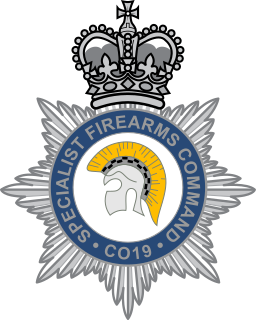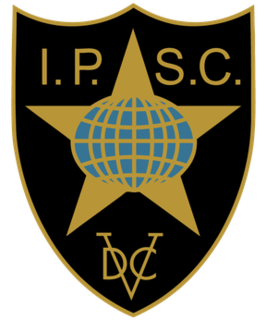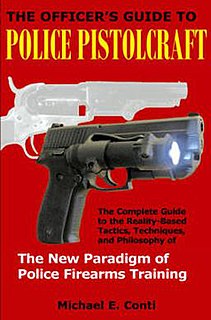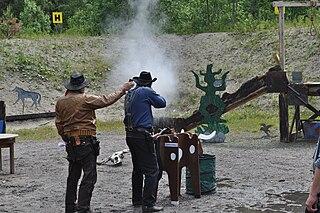
A firearm is any type of gun designed to be readily carried and used by an individual. The term is legally defined further in different countries.

Shooting sports is a group of competitive and recreational sporting activities involving proficiency tests of accuracy, precision and speed in shooting — the art of using ranged weapons, mainly small arms and bows/crossbows.
The International Defensive Pistol Association (IDPA), founded in 1996, is an organization based in Bogata, Texas, that has created a shooting sport based on defensive pistol techniques, using equipment including full-charge service ammunition to solve simulated "real world" self-defense scenarios. Shooters competing in defensive pistol events are required to use practical handguns and holsters that are deemed suitable for self-defense use and concealment garment that can conceal the handgun from view of bystanders.

The .38 Super, also known as .38 Super +P, .38 Super Auto, .38 Super Automatic, .38 Super Automatic +P, or 9×23mmSR, is a pistol cartridge that fires a 0.356-inch-diameter (9.04 mm) bullet. It was introduced in the late 1920s as a higher pressure loading of the .38 ACP, also known as .38 Auto. The older .38 ACP cartridge propels a 130-grain (8.4 g) bullet at 1,050 ft/s (320.0 m/s), whereas the .38 Super pushes the same bullet at 1,280 ft/s (390.1 m/s). The .38 Super has gained distinction as the caliber of choice for many top practical shooting competitors; it remains one of the dominant calibers in IPSC competition.
25 meter center-fire pistol is one of the ISSF shooting events, and is normally a men-only event. Its origin lies in competitions with military-style service pistols, and as such its history dates back to the 19th century.

In the United States (U.S.), a marksmanship badge is a U.S. military badge or a civilian badge which is awarded to personnel upon successful completion of a weapons qualification course or high achievement in an official marksmanship competition. The U.S. Army and the U.S. Marine Corps are the only military services that award marksmanship qualification badges. However, marksmanship medals and/or marksmanship ribbons are awarded by the U.S. Navy, U.S. Coast Guard, and U.S. Air Force for weapons qualifications. For non-military personnel, different U.S. law enforcement organizations and the National Rifle Association (NRA) award marksmanship qualification badges to those involved in law enforcement. Additionally, the Civilian Marksmanship Program (CMP) and the NRA award marksmanship qualification badges to U.S. civilians. Most of these organizations and the U.S. National Guard award marksmanship competition badges to the people they support who succeed in official competitions.

The Specialist Firearms Command (SCO19) is the firearms unit of the Metropolitan Police Service. The Command is responsible for providing a firearms-response capability, assisting the rest of the service which is not routinely armed.

A wildcat cartridge, often shortened to wildcat, is a custom cartridge for which ammunition and/or firearms are not mass-produced. These cartridges are often created in order to optimize a certain performance characteristic of an existing commercial cartridge.

Practical shooting, also known as dynamic shooting or action shooting, is a set of shooting sports where the competitors try to unite the three principles of precision, power, and speed, by using a firearm of a certain minimum power factor to score as many points as possible during the shortest amount of time. While scoring systems vary between organizations, each measures the time of which the course is completed, with penalties for inaccurate shooting. The courses are called "stages", and are shot individually by the shooters. Usually the shooter must move and shoot from several positions, fire under or over obstacles and in other unfamiliar positions. There are no standard exercises or set arrangement of the targets, and the courses are often designed so that the shooter must be inventive, and therefore the solutions of exercises sometimes varies between shooters.

Metallic silhouette shooting is a group of target shooting disciplines that involves shooting at steel targets representing game animals at varying distances, seeking to knock the metal target over. Metallic silhouette is shot with large bore rifles fired freehand without support out to 500 meters, and with large bore handguns from the prone position with only body support out to 200 meters. Competitions are also held with airguns and black-powder firearms. A related genre is shot with bow and arrow, the metal targets being replaced with cardboard or foam. The targets used are rams, turkeys, pigs, and chickens, which are cut to different scales and set at certain distances from the shooter depending on the specific discipline.

The International Practical Shooting Confederation (IPSC) is the world's largest shooting sport association, and the largest and oldest within practical shooting. Founded in 1976, the IPSC nowadays affiliates over 100 regions from Africa, Americas, Asia, Europe, the Middle East, and Oceania. Competitions are held with pistol, revolver, rifle, and shotgun, and the competitors are divided into different divisions based on firearm and equipment features. While everyone in a division competes in the Overall category, there are also separate awards for the categories Lady, Super Junior, Junior, Senior, and Super Senior.

A service pistol, also known as a personal weapon or an ordnance weapon, is any handgun issued to regular military personnel or law enforcement officers. Typically, service pistols are revolvers or semi-automatic pistols issued to officers, non-commissioned officers, and rear-echelon support personnel for self-defense, though service pistols may also be issued to special forces as a backup for their primary weapons. Pistols are not typically issued to front-line infantry. Before firearms were commonplace, officers and non-commissioned officers typically carried swords instead.

A handgun is a short-barrelled firearm designed to be held and used with one or two hands. The two most common handgun sub-types in use today are revolvers and semi-automatic pistols, although other handgun-types such as derringers and machine pistols also see infrequent usage.
Gallery Rifle Shooting or Gallery Rifle and Pistol shooting is a popular shooting sport throughout the world. In countries such as the UK, Ireland, Germany, South Africa and Australia national and international competitions are regularly undertaken. The discipline commonly uses rifles shot at short and medium distances chambered for traditional pistol calibers such as .22 Long Rifle, .38 and .357 calibers, .44 and .45. It is popular in countries where traditional pistol shooting is difficult or not possible. In the UK Long Barreled Pistols (LBPs) and Long Barreled Revolvers (LBRs) are also part of the overall discipline.
The modern technique is a method for using a handgun for self-defense, originated by firearms expert Jeff Cooper. The modern technique uses a two-handed grip on the pistol and brings the weapon to eye level so that the sights may be used to aim at the target. This method was developed by Cooper into a teachable system beginning in the 1950s, based on the techniques of shooters like Jack Weaver, Mike Rousseau and others, after experiments with older techniques such as point shooting. The method was codified in book form in 1991 in The Modern Technique of the Pistol by Gregory B. Morrison and Cooper.

The Officer's Guide to Police Pistolcraft is a 2009 non-fiction book by Michael E. Conti which covers combat-related situations arising in the course of standard law enforcement. Together with Police Pistolcraft, it forms the basis for the current pistol training program of the Massachusetts State Police and has been adopted by a range of other law enforcement jurisdictions.
Shooting sports in Canada are practised in various ways across the country. Canadians enjoy the sports at recreational and competitive levels, including international and at the Olympic level. Each province has its own organizations that govern the various disciplines. Many of the disciplines are connected nationally and some are part of larger international organizations.

Cowboy action shooting is a competitive shooting sport that originated in Southern California in the early 1980s, at the Coto de Caza Shooting Range in Orange County, California. Cowboy action shooting is now practiced in many places with several sanctioning organizations including the Single Action Shooting Society (SASS), Western Action Shootists Association (WASA), and National Congress of Old West Shooters (NCOWS), Single Action Shooting Australia (SASA), Western 3-Gun as well as others in the U.S. and other countries.

The French Shooting Federation (FFTir), FrenchFédération Française de Tir, is the umbrella organization for sport shooting in France. It was founded in its current form in 1967, but has roots as far back as 1866.














